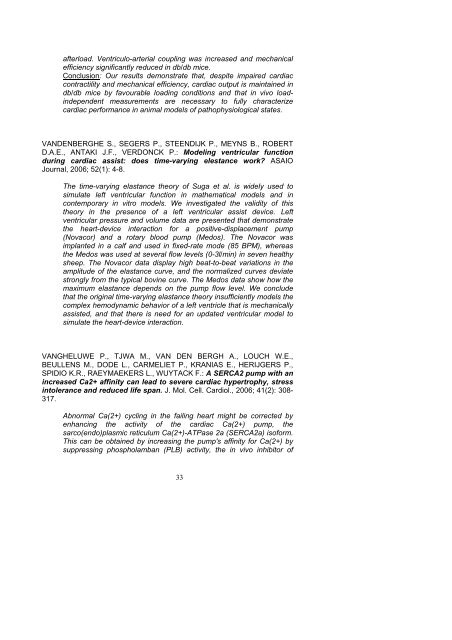2006 - UZ Leuven
2006 - UZ Leuven
2006 - UZ Leuven
Create successful ePaper yourself
Turn your PDF publications into a flip-book with our unique Google optimized e-Paper software.
afterload. Ventriculo-arterial coupling was increased and mechanicalefficiency significantly reduced in db/db mice.Conclusion: Our results demonstrate that, despite impaired cardiaccontractility and mechanical efficiency, cardiac output is maintained indb/db mice by favourable loading conditions and that in vivo loadindependentmeasurements are necessary to fully characterizecardiac performance in animal models of pathophysiological states.VANDENBERGHE S., SEGERS P., STEENDIJK P., MEYNS B., ROBERTD.A.E., ANTAKI J.F., VERDONCK P.: Modeling ventricular functionduring cardiac assist: does time-varying elestance work? ASAIOJournal, <strong>2006</strong>; 52(1): 4-8.The time-varying elastance theory of Suga et al. is widely used tosimulate left ventricular function in mathematical models and incontemporary in vitro models. We investigated the validity of thistheory in the presence of a left ventricular assist device. Leftventricular pressure and volume data are presented that demonstratethe heart-device interaction for a positive-displacement pump(Novacor) and a rotary blood pump (Medos). The Novacor wasimplanted in a calf and used in fixed-rate mode (85 BPM), whereasthe Medos was used at several flow levels (0-3l/min) in seven healthysheep. The Novacor data display high beat-to-beat variations in theamplitude of the elastance curve, and the normalized curves deviatestrongly from the typical bovine curve. The Medos data show how themaximum elastance depends on the pump flow level. We concludethat the original time-varying elastance theory insufficiently models thecomplex hemodynamic behavior of a left ventricle that is mechanicallyassisted, and that there is need for an updated ventricular model tosimulate the heart-device interaction.VANGHELUWE P., TJWA M., VAN DEN BERGH A., LOUCH W.E.,BEULLENS M., DODE L., CARMELIET P., KRANIAS E., HERIJGERS P.,SPIDIO K.R., RAEYMAEKERS L., WUYTACK F.: A SERCA2 pump with anincreased Ca2+ affinity can lead to severe cardiac hypertrophy, stressintolerance and reduced life span. J. Mol. Cell. Cardiol., <strong>2006</strong>; 41(2): 308-317.Abnormal Ca(2+) cycling in the failing heart might be corrected byenhancing the activity of the cardiac Ca(2+) pump, thesarco(endo)plasmic reticulum Ca(2+)-ATPase 2a (SERCA2a) isoform.This can be obtained by increasing the pump's affinity for Ca(2+) bysuppressing phospholamban (PLB) activity, the in vivo inhibitor of33

















